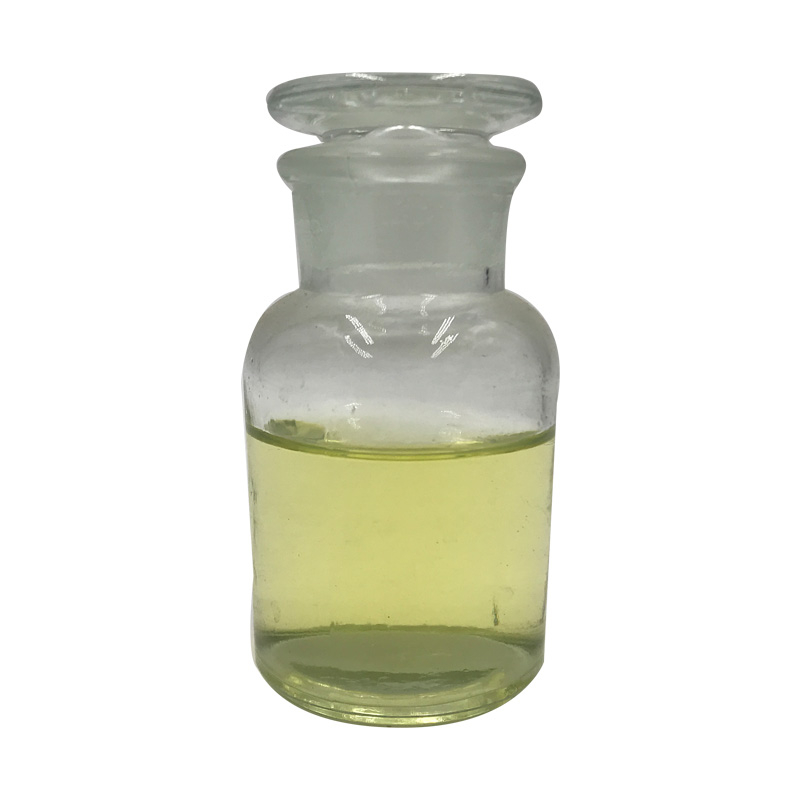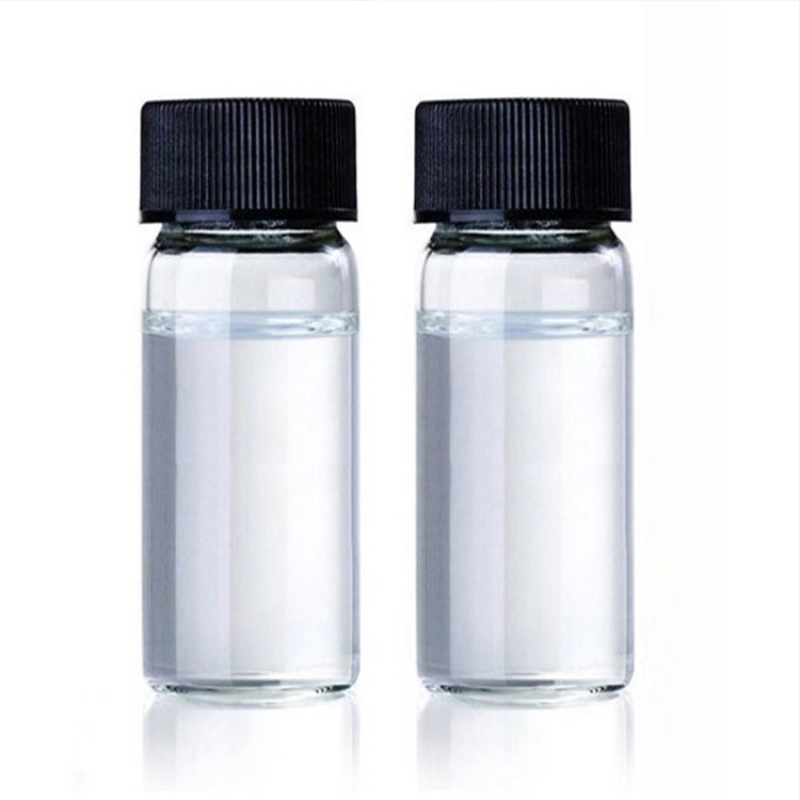Oleic acid CAS#112-80-1Chemical Properties: Oleic acid, C17H33COOH, also known as red oil, elaine oil, and octadecenoic acid, is a yellowish unsaturated fatty acid with an aroma similar to lard. Oleic acid consists chiefly of (Ζ)-9-octadecenoic acid together with varying amounts of saturated and other unsaturated acids. It is insoluble in water, but soluble in most organic solvents.
Contact Now
Products Description of Oleic acid CAS#112-80-1Insoluble in water, soluble in benzene, chloroform, miscible with methanol, ethanol, ether and carbon tetrachloride. Because it contains double bonds, it is easily oxidized by air, producing an unpleasant odor and turning yellow. When treated with nitrogen oxides, nitric acid, mercurous nitrate and sulfurous acid, it can be converted into oleic acid. When hydrogenated, it becomes stearic acid. The double bonds can easily react with halogens to form halogenated stearic acid.
Contact Now
Products Description of Oleic CAS#112-80-1Insoluble in water, soluble in benzene, chloroform, miscible with methanol, ethanol, ether and carbon tetrachloride. Because it contains double bonds, it is easily oxidized by air, producing an unpleasant odor and turning yellow. When treated with nitrogen oxides, nitric acid, mercurous nitrate and sulfurous acid, it can be converted into oleic acid. When hydrogenated, it becomes stearic acid. The double bonds can easily react with halogens to form halogenated stearic acid.
Contact Now
Products Description of 2-Phosphonobutane-1,2,4-tricarboxylic acid CAS#37971-36-12-Phosphonobutane-1,2,4-tricarboxylic acid (PBTC) is the latest generation of internationally popular phosphonic acid. It is one of the most widely used and best-performing products in the compounding of high-efficiency scale and corrosion inhibitors. This product is particularly suitable for water conditions with high temperature, high hardness, high alkalinity, high pH, and high concentration ratio.
Contact Now
1,4-Benzenedicarboxylic Acid, Compds. With Polyisobutenyl Succinic Anhydride-Tetraethylenepentamine Reaction Products CAS:68909-40-0Good dispersibility: It can be effectively dispersed in various solvents and matrices, which helps to improve the uniformity and stability of the product. Excellent thermal stability: It can maintain its stable performance at higher temperatures and is suitable for some high-temperature application scenarios.
Contact Now
Product DetailsProducts Description of Octadecenoic Acid CAS#112-80-1Insoluble in water, soluble in benzene, chloroform, miscible with methanol, ethanol, ether and carbon tetrachloride. Because it contains double bonds, it is easily oxidized by air, producing an unpleasant odor and turning yellow. When treated with nitrogen oxides, nitric acid, mercurous nitrate and sulfurous acid, it can be converted into oleic acid. When hydrogenated, it becomes stearic acid. The double bonds can easily react with halogens to form halogenated stearic acid.
Contact Now
Products Description of ASTRAZON PINK FG CAS#3648-36-0Dark red uniform powder. Dissolves in water to produce bright pink. When dyed at high temperature (120℃), the color does not change. If dyed in sulfuric acid bath, the color changes slightly, and when dyed in formic acid bath, the color does not change. Light fastness level 4.
Contact Now
Trihydroxymethylpropyl Trioleate CAS 11138-60-6Insoluble in water, soluble in a variety of organic solvents, such as ethanol, ether, acetone, etc. It has good chemical stability, but may decompose or react under high temperature, strong acid, strong alkali and other conditions.It has excellent lubrication properties and can effectively reduce friction and wear of mechanical equipment.
Contact Now
Products Description of 4-Morpholineethanesulfonic acid CAS#4432-31-92-Morpholineethanesulfonic acid is a white solid powder at room temperature and pressure. It is soluble in polar solvents such as water, ethanol, methanol, and acetone, but insoluble in non-polar solvents. Its molecular structure contains a morpholine ring and an ethanesulfonic acid group. The morpholine ring is a nitrogen-containing heterocyclic compound with high stability and inertness, and has no obvious toxicity or irritation to organisms.
Contact Now
Products Description of Coconut oil CAS#8001-31-8Coconut oil is an oil extracted from coconut pulp (dry pulp contains about 63% to 70% oil). It is a white semi-solid lard-like fat. It has a unique coconut fragrance. The main components are glycerides of lauric acid, myristic acid, and oleic acid. The melting point is 23 to 28°C. The relative density is 0.917 to 0.919 (25/25°C). The saponification value is 250 to 264. The iodine value is 8 to 12. The acid value does not exceed 6. It is soluble in alcohol, chloroform, ether, and carbon disulfide, but insoluble in water.
Contact Now
Products Description of Sodium Oleate CAS#143-19-1Sodium oleate, also known as sodium octadecenoate, cis-9-octadecenol, oleyl alcohol, cis-9-octadecenol, (Z)-octadecene-9-enol, olive oil alcohol, cis -9-Octadecen-1-ol, 9-n-octadecenol, octadecenol. It is an organic oil with the chemical formula C17H33CO2Na. Sodium acid acid is the main component of soaps made from olive oil and other soaps. It is also the main component of tallow soap. It can also be produced by the reaction of sodium hydroxide and oleic acid. It is a compound composed of hydrophobic and hydrophilic groups.
Contact Now
Products Description of Clotrimazole CAS#23593-75-1Clotrimazole is a synthetic azole antifungal drug that has inhibitory effects on a variety of pathogenic fungi and can also have a bactericidal effect at high concentrations.
Contact Now
Products Description of CARAMEL CAS#8028-89-5Caramel color is one of the food colorings with the longest history of human use. It is also the most widely used and popular food additive currently used by people. It has high color rate and strong coloring ability, reflecting the unique reddish brown color of fermented soy sauce, which is ruddy and bright. It has moderate viscosity, good solubility, high salt tolerance and stable quality.CARAMEL Chemical Propertiesdensity 1.35 g/cm3FEMA 2235 | CARAMEL COLOROdorat 100.00 %.
Contact Now
Products Description of Diethylenetriaminepenta(methylene-phosphonic acid) CAS#15827-60-8DTPMPA is used as a scale inhibitor for circulating cooling water and boiler water in water treatment. It is particularly suitable for alkaline circulating cooling water as a scale inhibitor without pH adjustment. It can also be used as a scale inhibitor for oil field injection water, cooling water and boiler water containing high barium carbonate. When this product is used alone in a compound agent, there is no need to add a dispersant, and the amount of dirt deposition is still very small.
Contact Now
Glacial Acetic Acid CAS# 64-19-7Product Overview:Glacial acetic acid, scientifically known as ethanoic acid, is a colorless, corrosive liquid that plays a pivotal role in various industrial processes. With the chemical formula CH₃COOH and the unique identifier CAS#64-19-7, it is a versatile compound that is widely recognized for its effectiveness in a multitude of applications.Market Relevance:In the dynamic industrial sector, the demand for high-quality chemicals is ever-increasing.
Contact Now
Products Description of Polyisobutylene CAS#9003-27-4Polyisobutylene (PIB) is a non-toxic, water-white viscous liquid that exhibits excellent low-temperature flexibility due to its low glass transition temperature. It is a linear saturated polymer with a highly flexible molecular chain, which contributes to its superior elasticity and extensibility. PIB is recognized for its high chemical stability and can be tailored to various applications by adjusting its molecular weight, ranging from low to high molecular weights with viscosities varying from 5 to 4,700 cSt @ 100°C.
Contact Now
Products Description of Hexamethylene diacrylate CAS#13048-33-4This product is a bifunctional monomer with low skin irritation, low shrinkage and high activity.
Contact Now
Products Description of Neosperidin dihydrochalcone CAS#20702-77-6Neohesperidin dihydrochalcone (NHDC) is a new sweetener that is hydrogenated from neohesperidin extracted from natural citrus plants. It has high sweetness, good taste, long-lasting aftertaste, and low calories.
Contact Now
99%Citric acid CAS#77-92-9Product Description:Introducing our high-quality Citric Acid Powder, a versatile and essential component in various industries, with the chemical abstract service number CAS#77-92-9.
Contact Now
Product Overview: Industrial-Grade Acetic AcidIntroducing our high-quality Industrial-Grade Acetic Acid (CAS #64-19-7), a versatile chemical solution designed to meet the needs of manufacturers and industrial users worldwide. Known for its effective properties and stable quality, this product serves as an essential building block across various applications in numerous industries.Product Details:Chemical Composition and PurityOur Industrial-Grade Acetic Acid is a reliable form of pure acetic acid known for its exceptional purity and consistency.
Contact Now
Acetic acid formula CAS#64-19-7Product Overview:Glacial acetic acid, scientifically known as ethanoic acid, is a colorless, corrosive liquid that plays a pivotal role in various industrial processes. With the chemical formula CH₃COOH and the unique identifier CAS#64-19-7, it is a versatile compound that is widely recognized for its effectiveness in a multitude of applications.Market Relevance:In the dynamic industrial sector, the demand for high-quality chemicals is ever-increasing.
Contact Now
Products Description of Octenyl succinic anhydride CAS#26680-54-62-Octenylsuccinic anhydride (OSA) is an important intermediate of fine chemicals. Because its molecule contains carbon-carbon double bonds and carboxylic acid ligands, it has high chemical reactivity. Under appropriate conditions, it can undergo a series of reactions such as addition, substitution, reduction, acetification, hydrolysis and polymerization. It can synthesize a variety of derivatives.
Contact Now
Products Description of Carnauba wax CAS#8015-86-9Extracted and refined from the leaves and buds of Brazilian palm, it is hard and brittle, insoluble in water, and is a hard, high-melting-point, shiny wax.
Contact Now
Products Description of Molybdenum disulfide CAS#1317-33-5Molybdenum disulfide, the main component of molybdenite, is a lead-gray to black solid powder. It feels greasy to the touch and has no odor. It belongs to the hexagonal or orthorhombic system, is similar to graphite, and has a metallic luster. Molybdenum disulfide is a good solid lubricant material. It has excellent lubricity for equipment under conditions of high temperature, low temperature, high load, high speed, chemical corrosion and modern ultra-vacuum.
Contact Now


































